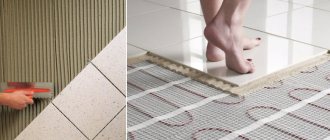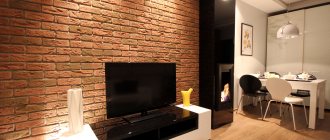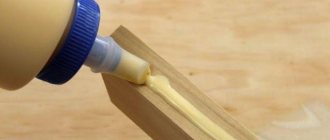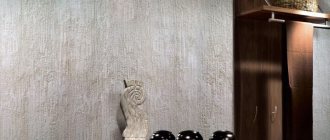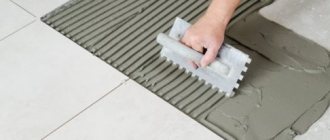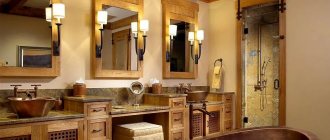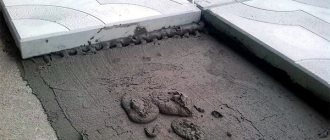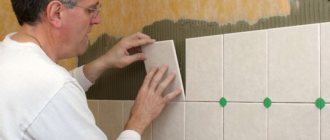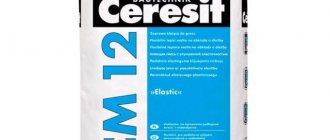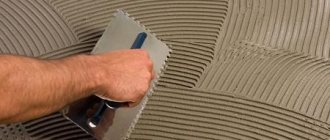Mosaic tiles allow you to decorate the interior and exterior walls of your home in an original way. Small decorative details that create a pattern are attached to the base using adhesives. The quality of the work and the durability of the result depend on whether the adhesive for the mosaic is chosen correctly. Let's look at what to look for when buying a mixture.
Types of glue
How can you glue mosaics? There are several types of suitable glue, any of them can be used. The product may contain mineral components, polymers, epoxy or other types of resins. In fact, it is permissible to glue the mosaic with the same materials as ordinary tiles and ceramics. But it is also important to take into account the type of base on which the mosaic is supposed to be laid. Thus, when covering drywall or plaster, ordinary tile adhesives are used, but when gluing wood or plastic, a special product is required.
Here are other tips for choosing quality glue:
- Glass mosaic is translucent, so it is better to use a transparent or white compound to attach it. The gray color will show through the glass and spoil the appearance of the material.
- To save time, it is better to glue the mosaic using quick-drying compounds. They can be bought at any hardware store.
- When laying natural and artificial stone, it is worth purchasing epoxy glue - it increases the moisture resistance of the material.
- If the wall surface is uneven, you should buy highly elastic leveling adhesives.
A mistake is gluing mosaics with “liquid nails” . This product is difficult to distribute in an even layer over a large area; it is suitable for spot application. Over time, due to an uneven adhesive layer, some mosaic chips will fall out.
Cement glue
Cement adhesives are sold in bags of 20-30 kg, their price is the lowest compared to analogues. They are white or gray in color and contain cement, alabaster, gypsum, sand, and a number of plasticizers and fillers.
Before gluing the tiles, you need to dilute the dry powder with water, liquid latex, and milk of lime (the norms are indicated in the instructions). It is important to take only very clean water, otherwise the snow-white composition may darken. The best option for applying cement adhesive is on concrete or brickwork. Drywall can get wet from such a product, and the glue does not adhere well to metal and glass.
Dispersion composition
This glue is a ready-made material in cans, which consists of mineral components, acrylic additives, and water. The product is more expensive than cement, but the ease of its use compensates for this disadvantage. The pasty white mass is very comfortable to work with and is easy to apply to the wall.
The hardening time is from 30 minutes, so the position of the tile can be adjusted in time. The remainder of the mixture is stored for a long time; it does not deteriorate under the lid of the package. In addition to mosaics, the dispersion composition is suitable for gluing tiles, clinker tiles, natural stone, and majolica.
Two-component adhesive
Two-component products consist of epoxy resin and hardener or are polyurethane-based. After connecting the components, a strong mass is obtained that is almost impossible to tear off.
It is these materials that are recommended to be used if you need to glue mosaics to a smooth surface - marble, glass, plastic, metal. Epoxy should also be used to attach ceramics to a wooden surface. Two-component adhesives are used for lining swimming pools, baths, saunas, and laundries, because they are waterproof. The disadvantage is the high cost of this type of funds.
Scope of application
The abundance of colors and interesting ideas for using mosaics allows you to use this material to decorate different parts of rooms.
In the living room
This is the room that everyone who comes to the house sees. Therefore, it should be cozy and tastefully furnished. Beautiful mosaic patterns will complement the interior perfectly.
Here you can place a panel made of small parts. It will look great on a free wall, next to which there is nothing, or above a sofa or table. In a Khrushchev building, such a decorative detail will seem unusual, but in a large, spacious apartment it will become a completely appropriate addition to the interior.
If you choose a beautiful metal or glass mosaic, then the pattern will, in addition to everything else, shimmer on the wall, adding a fairy-tale atmosphere to the room. The combination of different types of mosaics also looks interesting. More transparent tesserae can be combined with matte ones, experimenting with shine and colors.
Bathroom
Here mosaics can decorate the ceiling, floor or shelves
When searching for suitable tiles, you need to pay attention, first of all, to their quality, such as practicality and sustainability. After all, it is in the bathroom that most negative factors affect the appearance of tiles
Professionals recommend giving preference to smalt, since it wears off more slowly and at the same time looks no worse than other types. Such floor tiles can be either continuous or consisting of separate inserts. All kinds of floral or geometric patterns made from colored mosaics look beautiful.
Metal tiles also look appropriate in the bathroom. This mosaic is good because it shimmers beautifully when rays of light hit it. And if you make a large panel of metal mosaic, it will visually enlarge the room.
You can decorate not only the floor and the wall with tesserae. A mirror frame, a sink or even a toilet decorated with mosaics looks beautiful. As for the floor, the material for finishing it should be chosen one that you can safely walk on without slipping. Professionals advise choosing a mosaic with the lowest number indicated on the package.
Hallway
As a rule, this room is a walk-through room. But this does not mean that it can be ignored and not decorated at all. Mosaic here would be quite appropriate both on the walls and on the floor or even the ceiling. If there is no unnecessary furniture in the room, then you can decorate the entire wall by placing a large panel with an interesting plot pattern on it. You can also hang a large mirror in the hall, decorating its frame with small details.
In the hallway you can use mosaic tiles in interesting shades, for example, gradient or metallic colors, which can be golden or silver shades. They can make even a walk-through room feel luxurious. And if such a solution seems too pretentious, then you can limit yourself to tones that are more familiar to the eye.
Kitchen
It is advisable to divide a room intended for cooking and family gatherings into a work space and a relaxation area. It is advisable to protect the cooking area so that the walls are not stained with food during the cooking process. The simplest advice is to choose a beautiful mosaic apron to protect the space above the countertop. However, the table itself can also be decorated with mosaics of different colors. It is durable, does not scratch, does not fade and does not lose its attractiveness over time.
In some cases, mosaic banners even decorate cabinet doors and shelves. You should not choose too many bright colors so as not to create colorful chaos in your room. Most often, light-colored panels that are easy to clean are selected for the kitchen. You can also decorate the room with interesting patterns with images of food or some still lifes.
Adhesive manufacturers
On sale you can find domestic and imported brands of mosaic adhesives. Many modern materials are imported from China. The most popular ones are described below.
Ceresit CM 115
Adhesive for marble tiles and glass mosaics Ceresit CM 115 (“Ceresit CM 115”) is a white composition for exterior and interior use. It is used for fastening different types of tiles, stone, limestone, glass. The product is suitable for concrete, cement screeds, as well as heated concrete floors. It is water- and frost-resistant, resistant to tile sliding, and environmentally friendly.
After introducing the Ceresit SS 83 plasticizer, the adhesive mass will be suitable for attaching mosaics to wood, drywall, plaster, and old tile cladding. The glue does not leave stubborn stains and is very easy to use.
Bergauf Mosaik
Bergauf Mosaik adhesive for mosaics, tiles and swimming pools is packaged in 5 kg bags and is a white cement-based mixture. The composition also contains fractional sand, modifiers, polymers, and mineral fillers.
Recommended for work on balconies, tiling and mosaic facades, swimming pools, plinths, and a number of critical bases. It is possible to stick tiles on underfloor heating systems with the heating restarting 7 days after completion of work. Frost-resistant, highly adhesive, does not react to moisture.
Axton
Axton's special product is ideal for glass mosaics indoors (bathrooms, kitchens, lobbies, living rooms), as well as outdoors - fountains, facades. It glues stone and ceramic tiles just as well, and can be used in finishing swimming pools. To install heated floors, the material is mixed with latex additives.
"Litocol K 55"
Tile adhesive “Litokol K 55” is a dry adhesive mixture for interior and exterior work, based on white cement. Helps to bond all types of tiles and mosaics, including glass and natural stone. Can be used in wet rooms, swimming pools. White color does not change the shade of the base material and does not shine through. The composition has high ductility and excellent adhesion, preventing slipping of mosaics and tiles on vertical bases.
"Mapei"
Mapei Adesilex P10 is also part of the group of white cement-based adhesives. It helps to glue even such complex types of mosaics as mirror and glass, and is used for products made of tiles, ceramics, and marble. The distinctive qualities of “Mapey” are that they do not slip and remain open for a long time without deteriorating. The product is supplied in 25 kg bags.
Advice from the experts
Various compounds are suitable for gluing, including liquid nails or hot melt adhesive. Before laying the mosaic, experts advise assessing the following parameters:
- Materials for gluing. The nature of the base and decor is taken into account.
- Place of work. Mixtures are selected taking into account humidity and temperature exposure.
- Color. White is only needed when gluing transparent parts. In other cases, color does not matter.
- Evenness. Pre-leveling the base will reduce consumption per m2 and improve adhesion.
These recommendations will reduce costs without compromising the quality of finishing work.
The choice of glue determines how firmly the mosaic will hold and whether it will change color. By following the recommendations of the experts, you will be able to select a composition that ensures good adhesion and avoid unnecessary costs.
Tools and materials
To work with mosaics, you should measure the walls or floor, purchase the required amount of base material - small ceramic, plastic or other types of tiles. You also need to buy tile adhesive. There are various types of adhesive base on sale on which the mosaic will adhere perfectly. Here is a list of other materials and tools required for installation:
- grout for mosaic tile joints;
- crosses for forming joints;
- spatula with teeth;
- rubber spatula;
- gloves;
- sponge;
- bucket;
- construction mixer (if the glue is dry).
In the case where a self-adhesive mosaic is purchased, no adhesive is needed. Typically, this material is recommended to be glued to the wall in the kitchen, but in the bathroom, with constant contact with water, it does not last long.
Seam rubbing stage
To grout seams, it is best to take adhesive compositions of two components that are intended for a specific type of cladding, and it is especially good when they contain antiseptic additives.
This stage should be started 24 hours after laying the mosaic blocks.
To do this, prepare a grout solution and apply it lengthwise and crosswise with a rubber spatula. After final drying, the residues should be carefully removed with a foam sponge and polished with a flannel cloth.
Technology for gluing mosaics in the bathroom
It is most convenient to mount mosaic chips on a grid - they are sold in pieces or blocks, even a beginner can handle them. If this is required, you need to cut such modules with a construction knife. But how to properly cut individual elements, since repairs are unlikely to be completed without this? Usually you have to cut the mosaic next to the outlet or at the corners of the walls. Special roller cutters are used; they leave the edges smooth and even.
To cut holes in the sheet, you can remove the necessary segments from it, then carefully trim the tiles with wire cutters. It is also permissible to immediately cut a hole of the required size using a grinder.
Preparing the base
The wall must be perfectly leveled - otherwise a hole or unevenness covered with mosaic will stand out strongly, and individual chips will quickly peel off. The process for preparing a plastered wall is as follows:
- check the surface for voids and fill them with leveling mixture;
- sand the walls to remove even the smallest irregularities and bumps;
- seal the seams on the drywall and cover the heads of the screws;
- let the wall dry completely;
- wipe off the dust with a rag, apply priming to improve surface adhesion and reduce its absorbency;
- the tile will stick better if primed in 2 layers;
- When using transparent tiles in the bathroom, on the countertop in the kitchen, in addition to the primer, tinting is used.
Wall marking
Preliminary marking is very important, because individual elements are small and can move during installation. First, you should make a sketch, then repeat the markings on the walls. It should start from the outer corners (slopes, boxes) or from a mirror, a panel on the wall, or another large decorative element. It is more convenient to lay out the material dry on the floor.
Mosaic laying
The tiles are laid at a temperature of +5…+30 degrees. Start gluing the modules from the 2nd row. Each element with a pattern is first applied without glue to check the consistency of the decor.
Mosaic glue hardens quickly. A film on the surface begins to form after 20-30 minutes, so you should not immediately dilute a large volume of the product. It is much more convenient to use ready-made formulations. Do-it-yourself resin-based glue is diluted strictly in the required proportion with the hardener.
Gluing the mosaic
The finished adhesive mass is applied to the wall using an even spatula in a layer of 3-4 mm. Next, they pass over the glue with a notched trowel with a tooth height of 3 mm. Experts sometimes coat the mosaic itself with glue, which will ensure a more reliable bond. In this case, the layer should be 1-2 mm.
Tile is usually mounted on the wall from below, but mosaic is lighter and can be started from any area. But it’s still worth practicing in an inconspicuous area, for example, behind the bathroom. Individual elements are pressed against the wall or floor using crosses or by eye. After laying, you need to tap the square to remove excess air.
Surface cleaning
After 30 minutes, you can remove excess glue using a stick, a brush with hard bristles, or a match. Cleaning should not be done immediately so that the mosaic does not come off. Afterwards, you can remove the remnants of the paper protection that is on the front side of the blocks. Start from the bottom right row, moving to the last one. The paper needs to be slightly wet first.
Grouting joints
For grouting, use two-component mixtures that are suitable for the specific type of material. Ideally, they contain antifungal components. The work is carried out a day after gluing the mosaic. Dilute the mixture, apply it horizontally and vertically using a rubber spatula. As the grout dries, it is washed off the chips with a sponge, then the surface is polished with flannel.
How to lay mosaic tiles: step-by-step instructions
- The first step is to prepare the working surface: sand it well so that there are no uneven surfaces, remove dust, dirt and remnants of the old coating. To more accurately fix the tiles, it is recommended to make markings on the base to be tiled.
- Having chosen the best mosaic adhesive for a given situation, you need to stir it. The exception is a one-component ready-made composition. When calculating the proportions of ingredients, you should follow the manufacturer's instructions so that the mixture is not too liquid and not thick.
- Mosaic tile adhesive is applied with a special notched spatula. The adhesive solution must be evenly distributed over the surface to be treated. For stronger adhesion, you can lubricate both the base and the tile.
Important! The back side of the glass mosaic must be covered with an even layer of glue. If you apply the fixing mixture only to the wall with a notched trowel, the resulting grooves will be visible through the transparent material.
- Regardless of which mosaic adhesive is used, it is necessary to achieve maximum adhesion between the surfaces. To do this, you can gently tap the tile, pressing it in a little. In order for the mosaic to lie flat, you need to adjust the position of its individual elements.
- After one to two days, you can grind the seams. You should start cleaning the mosaic no earlier than twenty minutes later. It is not recommended to use a sponge that is too wet for this, as water may damage or wash away the grout.
Mosaic on mesh or paper
In order not to waste time gluing each element, block mosaic was invented. It is produced in separate squares mounted on a grid or paper. The pattern is formed from blocks, which is much faster, and the result will be the same, even more beautiful due to even laying.
The glue for such material can be anything. It is only important to carefully consider the markings, and during the gluing process, make sure that the mesh is evenly coated with the solution. Since the tiles are held together by paper at the front, you will have to lubricate the base material, subsequently removing the paper protection.
Laying stage
As a rule, tiles must be glued at temperatures from +5 to +30 degrees. Laying of mosaic modules is carried out from the second row. To ensure the combination of decor, each detail is pre-applied without the use of adhesive.
“The adhesive mixture for such material usually hardens quite quickly. The film forms after 20-30 minutes. Therefore, you should not prepare a lot of glue at once. Of course, it’s easier to take ready-made products.
The adhesive solution from the resin must be prepared, adhering to proportional ratios, and a hardener must be added there.”
Bonding surfaces
Depending on the type of base on which the mosaic is applied, the specifics of the work may vary. There are a number of features when choosing and applying adhesives to old tiles, wood, and drywall.
On tiles
If you don’t want to remove the old tiles in the bathroom, you can glue the mosaic covering directly on top of it. What glue is used for this work? A silicone product or sealant for gluing aquariums is ideal. Also, high-quality epoxy glue in the form of a two-component composition is suitable for such work. Old tiles must first be degreased and cleaned of dirt and soap stains.
On a tree
For this base, two-component glue or a ready-made dispersion acrylic composition can also be used. But first you should go over the wood with a primer 2-3 times in order to minimize the absorbency of the material. If you decide to glue the mosaic onto plywood, then the thickness of the latter should not be less than 0.7 cm. A highly elastic adhesive is selected that will not crack under load.
On drywall
Laying mosaics on drywall is the simplest; the material will hold firmly for a long time. It is important to pre-coat the joints of the sheets with putty, which will increase the reliability of the structure. Next the surface is primed. The mosaic is attached with cement glue and a water-dispersion composition.
Features of gluing certain types of mosaics
There are various types of material on sale, but ceramic mosaics are still the most popular. Mirror tiles look original - they increase space and add light. Smalt chips are made from opaque glass that has a unique appearance. The glass melt is tempered at high temperatures and then subjected to special treatment. This mosaic is often covered with rhinestones and beaded patterns, and is used to create beautiful panels. Venetian glass mosaics are very expensive, but they allow you to create real masterpieces in your bathroom.
Glass and mirror mosaics - installation features
The surface of the glass has no pores, so it is impenetrable to water and microbes. The material tolerates household chemicals well and is excellent for tiling bathrooms. To ensure reliable adhesion of the tiles to the wall, it is important to thoroughly wash and degrease the surface. It is advisable to cover it with white paint to make the elements look more elegant. The wall is covered with reliable glue with a transparent base (epoxy, polymer), then mosaic sheets are laid.
Natural stone products
Stone chips are made from jasper, onyx, and marble. This material looks expensive and very beautiful, especially after additional polishing and artificial aging. The stone has pores; its care must be careful due to its ability to deteriorate. The composition should be applied to the back of the modules, so it is better to buy mosaics on a grid. Any type of adhesive can be used, but the best option is epoxy.
Plastic mosaic
This option will be a cheap replacement for natural materials. Such mosaic slabs are made from PVC, which is resistant to water and temperature changes and is famous for its durability. To attach such material, you can use hot glue and even “liquid nails”. Foamed PVC reacts well to all types of adhesives, especially if the surface is well leveled and cleaned. Such a mosaic can imitate wood, stone, glass and helps make repairs efficiently and without extra costs.
Choice: what to consider?
When purchasing mosaic adhesive, you should rely on the type of tile, the characteristics of the substrate to be coated and the type of room. Before purchasing, it is recommended to determine the exact timing of the work. If you don’t have a lot of time, it is better to use a quick-hardening compound.
Surface quality
If there is a smooth and clean surface, the adhesive will be easy to apply even with a silicone spatula, and the mosaic tiles will remain level and long-lasting. On such walls, the mosaic pattern looks like it is made of beads. Decorative elements can be laid on a plastered wall or cement screed using any glue. When the cladding is carried out on a rough or waterproofing base, you need to use highly elastic adhesive with a polyurethane or epoxy base.
Character of the room
Laying any tile in a warm room is quite simple, but it’s another matter when you need to tile walls and floors that will be constantly exposed to moisture. Such places are a swimming pool, steam bath, fountains. In this case, you should choose an adhesive composition with special characteristics. One of the main features should be the ability to absorb moisture. The second requirement is the high elasticity of the mixture, which will facilitate stable fixation of the mosaic to the base.
In areas with high humidity, an important criterion for choosing glass tiles is the level of adhesive adhesion. The waterproof mixture must have an adhesion of at least 2.5 MPa, which will ensure optimal adhesion of the glass surface and the waterproofing base of the pool. However, the maximum strength of the fastening is provided by a mosaic adhesive composition diluted with liquid latex; in this case, the composition acquires a slight diamond shine. It should be remembered that after laying the tiles inside the pool, it will be possible to fill it only after two, or better yet, three weeks. A similar condition is necessary for the final hardening of the glue and fixation of the mosaic on the surface.
In the case of lining an outdoor pool, the air temperature must also be taken into account, which should be above +5 degrees.
